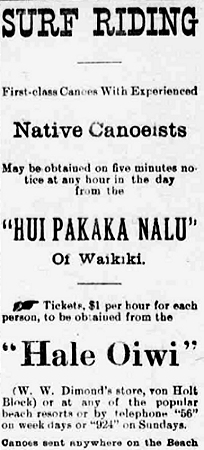 |
surfresearch.com.au
newspapers :
1897
|
Newspapers : 1897.
| home | catalogue | history | references | appendix |
 |
surfresearch.com.au
newspapers :
1897
|
|
|
|
|
|
|
|
|
|
|
|
|
|
|
|
|
|
|
|
|
First-class Canoes With Experienced Native Canoeists May be obtained on five minutes notice at any hour of the day from the "HUI PAKAKA NALU" Of Waikiki. Tickets, $1 per hour for each person, to be obtained from the "Hale Oiwi" (W. W. Dimond's store, von Holt Block) or at any of the popular beach resorts or by telephone "56" on week days or "921" on Sundays. Canoes sent anywhere on the Beach |
 |
BATTLE WITH THE SHARKS.
(Etching)
FRANK
DAVEY,
President
Davey Photograph Co.
HAWAIIAN SHARK KILLERS
|
|
|
|
|
|
|
|
|
|
|
|
|
|
|
|
|
|
|

| home | catalogue | history | references | appendix |